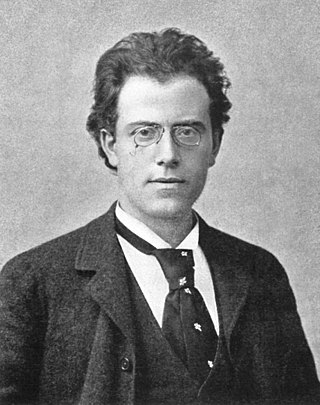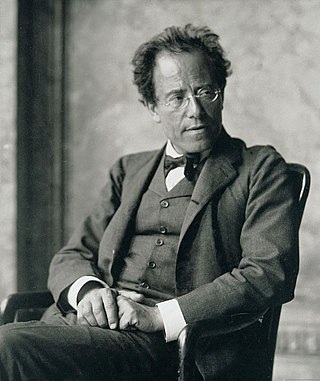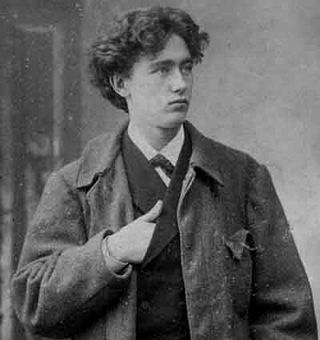This article needs additional citations for verification .(February 2021) |
The Chamber Symphony is an instrumental work by Austrian composer Franz Schreker.
This article needs additional citations for verification .(February 2021) |
The Chamber Symphony is an instrumental work by Austrian composer Franz Schreker.
The work was composed in 1916 for the centenary of the Vienna Music Academy where Schreker had been teaching since 1912. [1] The musical material is partly derived from an abandoned opera project entitled Die tönenden Sphären for which Schreker wrote the libretto and part of the music in 1915. [2]
The work compresses the four movements of a traditional symphony into a single larger one, after the example of Arnold Schoenberg’s Chamber Symphony No. 1 . [1]
The work lasts approximately 25 minutes in performance.
The work was first performed on 12 March 1917 by an orchestra consisting of professors from the Vienna Academy, conducted by the composer. [1] The work was also performed at the composer's memorial concert in Vienna in March 1935. [2] It is one of Schreker’s most frequently performed compositions.
Although often described as a work for 23 solo instruments, the orchestral requirements actually stipulate a minimum of twenty-four players: flute, oboe, clarinet in B flat/A, bassoon, horn, trumpet, trombone, timpani, percussion (xylophone, glockenspiel, cymbals, triangle, tam-tam), harp, piano, celesta, harmonium, and a small string section consisting of four violins, two violas, three cellos and two double basses. [3] In the preface to the score, the composer recommends augmenting the strings for performances in larger halls. [4]

Franz Schmidt, also Ferenc Schmidt was an Austro-Hungarian composer, cellist and pianist.

Franz Peter Schubert was an Austrian composer of the late Classical and early Romantic eras. Despite his short life, Schubert left behind a vast oeuvre, including more than 600 secular vocal works, seven complete symphonies, sacred music, operas, incidental music, and a large body of piano and chamber music. His major works include the art songs "Erlkönig", "Gretchen am Spinnrade", "Ave Maria"; the Trout Quintet, the unfinished Symphony No. 8 in B minor, the "Great" Symphony No. 9 in C major, the String Quartet No. 14 Death and the Maiden, a String Quintet, the two sets of Impromptus for solo piano, the three last piano sonatas, the Fantasia in F minor for piano four hands, the opera Fierrabras, the incidental music to the play Rosamunde, and the song cycles Die schöne Müllerin, Winterreise and Schwanengesang.

The Symphony No. 1 in D major by Gustav Mahler was mainly composed between late 1887 and March 1888, though it incorporates music Mahler had composed for previous works. It was composed while Mahler was second conductor at the Leipzig Opera in Germany. Although in his letters Mahler almost always referred to the work as a symphony, the first two performances described it as a symphonic poem and as a tone poem in symphonic form, respectively. The work was premièred at the Vigadó Concert Hall in Budapest, Hungary, in 1889, but was not well-received. Mahler made some major revisions for the second performance, given at Hamburg, Germany, in October 1893; further alterations were made in the years prior to the first publication, in late 1898. Some modern performances and recordings give the work the title Titan, despite the fact that Mahler only used this label for the second and third performances, and never after the work had reached its definitive four-movement form in 1896.

Universal Edition (UE) is an Austrian classical music publishing firm. Founded in 1901 in Vienna, it originally intended to provide the core classical works and educational works to the Austrian market. The firm soon expanded to become one of the most important publishers of modernist and contemporary classical music.

The Symphony No. 10 in F-sharp major by Gustav Mahler was written in the summer of 1910, and was his final composition. At the time of Mahler's death, the composition was substantially complete in the form of a continuous draft, but not fully elaborated or orchestrated, and thus not performable. Only the first movement is regarded as reasonably complete and performable as Mahler intended. Perhaps as a reflection of the inner turmoil he was undergoing at the time, the 10th Symphony is arguably his most dissonant work.

Esa-Pekka Salonen is a Finnish conductor and composer. He is the music director of the San Francisco Symphony and conductor laureate of the Los Angeles Philharmonic, Philharmonia Orchestra in London and the Swedish Radio Symphony Orchestra.

Franz Schreker was an Austrian composer, conductor, librettist, teacher and administrator. Primarily a composer of operas, Schreker developed a style characterized by aesthetic plurality, timbral experimentation, strategies of extended tonality and conception of total music theatre into the narrative of 20th-century music.

Paul Felix Weingartner, Edler von Münzberg was an Austrian conductor, composer and pianist.
Walter Rabl was a Viennese composer, conductor, and teacher of vocal music. Largely forgotten today, Rabl left only a small number of works, all of them early ones, from the twilight of the Romantic era. At the age of 30 he stopped composing entirely and devoted himself to conducting and vocal coaching the rest of his life.

Hungarian Rhapsody No. 2 in C-sharp minor, S.244/2, is the second in a set of 19 Hungarian Rhapsodies by composer Franz Liszt, published in 1851, and is by far the most famous of the set.

Wolfgang Amadeus Mozart's Horn Concerto No. 4 in E-flat major, K. 495 was completed in 1786.

Die Gezeichneten is an opera in three acts by Franz Schreker with a German-language libretto by the composer, based on Frank Wedekind's play Hidalla.

Der Schatzgräber is an opera in a prologue, four acts and an epilogue by Franz Schreker with a libretto by the composer.

Alexander Zemlinsky or Alexander von Zemlinsky was an Austrian composer, conductor, and teacher.

The Skandalkonzert was a concert conducted by Arnold Schoenberg, held on 31 March 1913. The concert was held by the Vienna Concert Society in the Great Hall of the Musikverein in Vienna. The concert consisted of music by composers of the Second Viennese School.

Karol Rathaus was a German-Austrian Jewish composer who immigrated to the United States via Berlin, Paris, and London, escaping the rise of Nazism in Germany.
The Percussion Concerto No. 2 is a concerto for solo percussion and orchestra by the Scottish composer James MacMillan. The work was jointly commissioned by the Netherlands Radio Philharmonic, the Philharmonia Orchestra, the Orchestre national du Capitole de Toulouse, the Cabrillo Festival of Contemporary Music, the Baltimore Symphony Orchestra, and the São Paulo State Symphony. It was first performed on November 7, 2014 at TivoliVredenburg in Utrecht, the Netherlands, by percussionist Colin Currie and the Netherlands Radio Philharmonic under conductor James Gaffigan. The composition is MacMillan's second percussion concerto after 1992's Veni, Veni, Emmanuel.

Richard Strauss composed his Symphony No. 1 in D minor in 1880 when he was just 16 years old. It consists of four movements, and lasts about 34 minutes. Although Strauss did not give a number to the symphony, it is often referred to as his First Symphony. It was premiered on 30 March 1881 at the Munich Academy of Music under the baton of Hermann Levi.
Der Geburtstag der Infantin is a “dance-pantomime” in one act by Austrian composer Franz Schreker, based on the Oscar Wilde novella The Birthday of the Infanta.
Kolja Lessing is a German violinist, pianist, composer and academic teacher. His focus as a soloist and chamber musician has been the neglected repertoire by composers who were ostracised under the Nazi regime. His recordings include four volumes of works by students of Franz Schreker in his master classes in Vienna and Berlin.